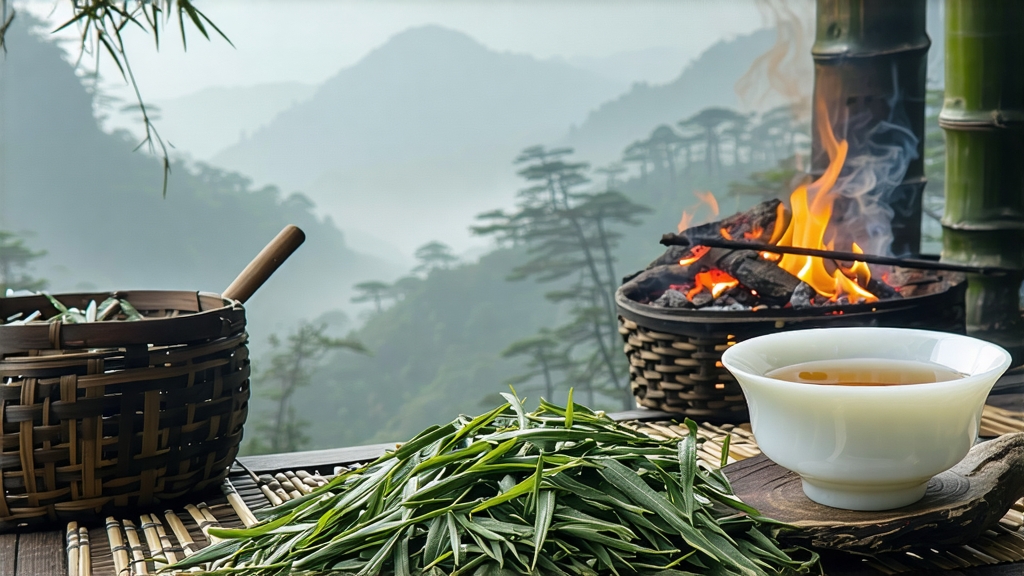
Few beverages carry as much myth and mispronunciation as Lapsang Souchong, yet every sip of this crimson liquor is a time-machine to the 17th-century trading posts where the global story of black tea began. Originating in the Wuyi Mountains of northern Fujian—an amphitheatre of granite cliffs, running springs and mineral-rich laterite soil—Lapsang Souchong is universally cited as the earliest intentionally oxidised tea, the prototype that taught the world how to turn green leaf into black gold. Locals still call it Zheng Shan Xiao Zhong—“Small Leaf from the Original Mountain”—a name that stakes territorial pride in the 1,200-metre-high nature reserve known as Tongmu Guan, a mist-locked village where access is restricted to protect centuries-old tea gardens and their accompanying biodiversity of ferns, wild orchids and slow-growing pine.
History first mentions the style in 1646, when Qing soldiers reportedly commandeered tea factories during the transition from Ming loyalists; hurried farmers dried leaf over fresh pine fires so it would travel fast to the coast before spoilage. The accidental smoke perfumed the tea so memorably that Dutch and later British merchants declared it “bohea” (from the Wuyi pronunciation) and shipped it to Amsterdam and London alongside porcelain and silk. By the early 18th century Lapsang Souchong was priced above green tea at Mincing Lane auctions, inspiring the East India Company to transplant Fujian cultivars to colonial India, effectively seeding Assam and Darjeeling industries. Thus every modern black tea owes a stylistic debt to this pine-smoked forebear.
Botanically the tea is made from a Xiaoyezhong (“small-leaf”) cultivar, a close cousin of the tea plants that later migrated to Keemun and Yunnan but adapted to Wuyi’s short, cool springs and rocky, fast-draining slopes. The genuine Tongmu leaf is noticeably smaller, olive-brown when dry, and carries a natural hint of dried longan that becomes the canvas for smoke. Because the village lies inside a national park, pesticides are forbidden; instead farmers encourage ladybugs and spiders to patrol the bushes, while wild boar and silver pheasant manure quietly enriches the soil. Such terroir gifts the leaf a high concentration of linalool and geraniol, floral volatiles that harmonise with resinous smoke to create the tea’s signature “fruit-campfire” aroma.
Two distinct styles exist today. Traditional Song Zhong (Pine-Smoked) is still produced in Tongmu’s three tiny hamlets—Mashu, Guadun and Miaowan—using the ancient craft that UNESCO lists as intangible cultural heritage. Fresh leaves are withered over open pinewood hearths built into the floor of the factory; the smoke rises through bamboo slats, curling around the leaf for six to eight hours while moisture drops from 75 % to 45 %. Once supple, the leaf is rolled on rattan mats until cell walls rupture, then oxidised in cedar-lined boxes where humidity and 28 °C heat turn it a coppery mahogany. Finally the tea is re-roasted above slow-burning pine logs whose resin has been previously reduced by half-drying; this “double smoke” fixes the fragrance while adding a subtle sweetness reminiscent of toasted marshmallow. A single kilo requires forty kilos of pine wood, all harvested from designated forest plots replanted on a seven-year rotation.
The second style, Wuyi Black or “Unsmoked Lapsang,” emerged for modern markets that crave the malt and cocoa of the leaf itself. Here the same leaf is withered with warm air ducted from electric heaters, oxidised normally, then baked in cast-iron ovens fuelled by local hardwood but no pine. The result is a sleek, chocolate-amber liquor closer to Keemun or Ceylon, yet still whispering the Wuyi minerality some tasters describe as “wet stone after rain.” Purists debate authenticity, yet both versions share the genetic fingerprint of Tongmu terroir and must pass strict geographic-origin certification to bear the Zheng Shan Xiao Zhong label.
Craftsmanship hinges on timing. Plucking occurs only between Qingming and Grain Rain, when two leaves and a bud reach the size of a sparrow’s tongue yet remain tender enough to snap cleanly.